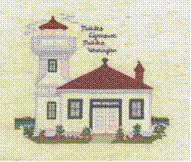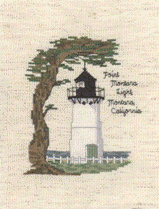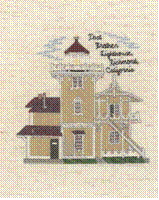Point Montara Lighthouse
Point Montara, California
Erected on a concrete foundation, this cast-iron conical tower stands 30
feet tall with a focal plane of 70 feet above sea level. Its light can be seen 14 miles out to sea.
Automated in 1970, it has been maintained by the U. S. Coast Guard since World War II. The original
Fresnel lens was transferred to the San Mateo Historical Society upon automation. It is now on display
in the library at the College of Notre Dame of San Mateo, California. The complex of turn-of-the-century buildings has been restored and now serves as a youth hostel, part of
the International-American Youth Hostels.

Tillamook Rock Lighthouse, Ecola State Park, Oregon
Along the coasts of
Oregon rage some of the fiercest storms ever witnessed. Wind speeds
over 90 miles per hour are well-known to those living along the shores.
Debris hurled ashore cause severe damage.
Here, Tillamook Rock sits where waves crash over the top and many ships lost
their way to crash upon the sides.
In calmer times, whales rub against the rocks to loosen barnacles, while
dolphins and seals frolic, with seabirds
wheeling overhead. Set in one of the most inaccessible locations for a
lighthouse, Tillamook Rock Lighthouse was
established through a perilous and lethal beginning.
Pigeon Point Lighthouse, Pescadero, California
The glass-enclosed lantern room at the top of the tower contains the
lighthouse’s original first-order Fresnel lens. This lens came from the Fort
Sumter lighthouse, which was buried to protect it during the Civil War. The lens
is mounted on wheels and the turning-mechanism is powered by a gravity-driven
clockwork system, similar to a grandfather clock. The entire lens assembly
rotates once every four minutes to produce a flash of light every 10 seconds.
The lamp used in 1872 generated light using a burner made up of five concentric,
open-flame wicks, fueled by lard oil. It produced 70,000 candlepower.
Mulkiteo Lighthouse, Mulkiteo, Washington
In 1905, due to increased maritime traffic through Possession Sound into Everett
and points further south, the Lighthouse Service determined that this area of
Puget Sound needed the aid of a lighthouse. After obtaining 2.6 acres of land,
architect Carl W. Leick was commissioned to design and build the lighthouse.
Standing at 30 feet tall with a focal plane of 33 feet above sea level, the
lighthouse was completed in 1906. The fourth-order Fresnel lens was illuminated
for the first time on March 1, 1906 and was “considered without exception the
most up-to-date and thoroughly equipped station on the Sound” (The Seattle
Times).
Kilauea Point Lighthouse, Kanai, Hawaii
Constructed and illuminated in 1913 at the northernmost point of the Hawaiian Islands, it is located on
the island of Kauai. Standing 180 feet above the sea, the 53 foot tall tower has a focal plane of 216 feet
above sea level. This was the last staffed lighthouse in the Hawaiian Islands. The Coast Guard moved its
aero beacon to a new stand, a monopole, which is still active. In 1985, the area officially became the
Kilauea Point National Wildlife Refuge, at which time the Coast Guard transferred the old light station
to the Fish and Wildlife Service. The lighthouse is now part of the refuge, and open to the public.
East Brother Lighthouse,
Richmond, California
Rather than haggle over the price of land for this
lighthouse, the Lighthouse Board chose to build on East Brother Island instead of
Point San Pablo. Construction was begun on the lighthouse and fog signal in 1873
by blasting off the top of the island to get a level surface. Completed the
following year, the flashing light was exhibited on March 1.

Old Point Loma Lighthouse,
San Diego, California
This lighthouse guided ships along the coast and into San Diego harbor for 36 years. Due to its height,
the Lighthouse Board chose to build a new tower on a site just a few feet above sea level. Turned over to the
National Park Service by President Roosevelt in 1933, the lighthouse was restored that later became a tea room,
book store and office space, until it was refurnished to depict the life of a lightkeeper and his family.
Point Arena Lighthouse, California
In April of 1906 a devastating quake struck San Francisco. The movement of
the
earth was even more powerful near the town of Point Arena, 130 miles north,
which was nearly destroyed.
The lens, tower and dwellings were damaged so badly that the tower was
ultimately condemned and torn down.
The once-ornate keepers' residence was also damaged beyond repair. Only the
wood-framed fog signal building survived. The new tower was quake-proof, made by a company specializing in smokestack
chimneys. Standing 115 tall, the salvaged spiral staircase
and lens room from the old tower were used.
“For Thou wilt light my candle:
the Lord my God will enlighten my darkness.”
—Psalm 18:28








